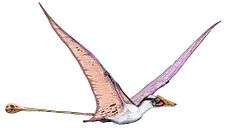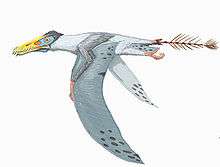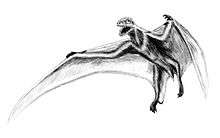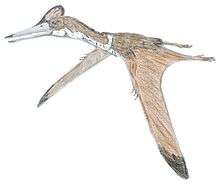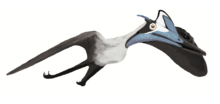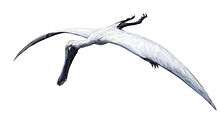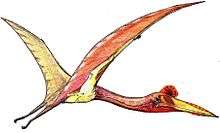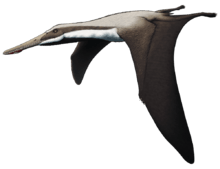Xericeps
Xericeps is a genus of pterosaur from the Late Cretaceous Kem Kem Beds (which date to the late Albian or Cenomanian age) of southeastern Morocco.
| Xericeps | |
|---|---|
| Scientific classification | |
| Kingdom: | Animalia |
| Phylum: | Chordata |
| Order: | †Pterosauria |
| Suborder: | †Pterodactyloidea |
| Clade: | †Azhdarchoidea |
| Genus: | †Xericeps Martill et al., 2018 |
| Type species | |
| †Xericeps curvirostris Martill et al., 2018 | |
The name Xericeps comes from the Ancient Greek: ξερός - meaning dry, referencing the Sahara Desert, in which the pterosaur was first found, and the Latin: cep from capere, meaning "to catch" - alluding to the creature's forceps-like beak.[1]
Description
Xericeps is a medium-sized edentulous (toothless) pterosaur, likely closely related to Alanqa. The term 'medium-sized', in the context of pterosaurs, is generally used to describe pterosaurs with a wingspan of 3–8 metres, and it is likely that Xericeps was nearer the lower end of this range.[1]
The holotype specimen is a partial anterior lower jaw, likely broken off right anterior to where the mandibular rami diverged. The jaw is upturned, with the occluding surface curved in lateral view. On the dorsal surface of the mandibular symphysis are a pair of ridges, similar to those seen in Alanqa and Argentinadraco.[1]
Discovery and naming
The holotype specimen - FSAC-KK-10700 was discovered by local mine workers at Aferdou N'Chaft, a small mesa near the oasis village of Hassi el Begaa in the Errachidia Province in south eastern Morocco on the Algerian border, and consists only of the pterosaur's fragmented jaws. The specimen was purchased directly at the mine site by British palaeontologist David M. Martill in January 2017, and thus it is possible to confidently establish its precise locality and stratigraphic horizon.[1]
It is believed that Xericeps lived in the mid-Cretaceous period around the Albian-Cenomanian ages (93.9-113.0 Ma).[1]
The holotype specimen's species epithet - "curvirostris" - comes from the Latin curvus, meaning "curved" and rostrum meaning snout, or muzzle. This is due to the specimen's noticeably upward-curved beak.[1]
See also
- Timeline of pterosaur research
- List of pterosaurs
- 2018 in paleontology
References
- Martill, David M.; Unwin, David M.; Ibrahim, Nizar; Longrich, Nick (2018). "A new edentulous pterosaur from the Cretaceous Kem Kem beds of south eastern Morocco". Cretaceous Research. 84: 1–12. doi:10.1016/j.cretres.2017.09.006.
